Will the UK's gas holders be missed?
- Published
Gas holders helped warm the UK's homes for decades. But now they are being removed, with the National Grid saying land is being "redeveloped and given back to communities". Will these sentinels of the industrial age be missed?
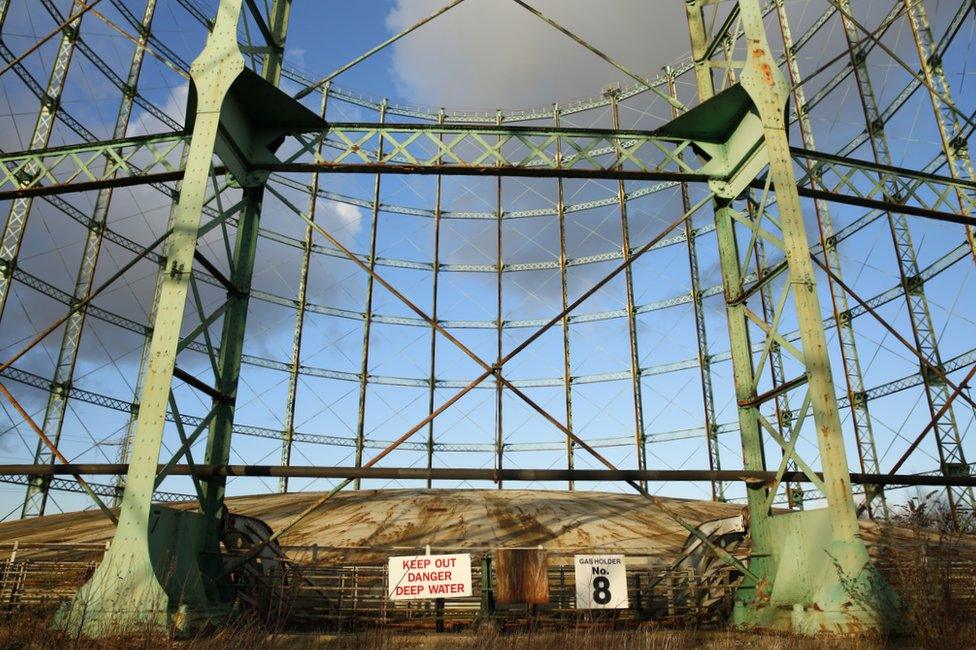
Gas Holder Number Eight at Washwood Heath in Birmingham
In the 200 years that the UK has been using gas power, the country has got used to the distinctive sight of "gasometers".
These gas holders have stored coal gas (town gas) and later natural gas for the UK's urban areas, but now all but a handful are obsolete.
After natural gas was discovered in the North Sea in 1965 the UK gas network went through a massive process of conversion. Town gas stopped being used and North Sea gas started to be transported into the UK under high pressure in pipes.
From then on, it was only when extra capacity was needed in the gas network that gas holders would be used. As the network of pipelines became larger and more effective, these occasions became fewer.
Time-lapse footage shows Northampton Gas Holder being dismantled
By the 1990s, most local gas networks were able to function at full capacity without the use of gas holders. In 1999, a decision was made to start demolishing them. Now, with property prices at record highs in much of the UK, the National Grid is dismantling them and selling off the land.
Our skylines are littered with their massive metal frames. The National Grid owns over 500 gas holders. And there are others owned by other companies.
Though they are now defunct, it's undeniable that they continue to play a part in British culture. Perhaps the most famous British gas holder looks over the Oval cricket ground. Like the pigeons that perch on it, it's been a subject of Test Match Special presenter Henry Blofeld's ramblings for decades.
For artists they have a dystopian edge. Raves spring up and are closed down around them and in the 1997 film Shooting Fish the protagonists, perhaps unrealistically, tried to live in one.
Sarah O'Carroll has been documenting the gas holders online since she learned of their gradual demise. "As a child I remember being confused about what they were for," says O'Carroll, a 40-year-old software engineer who lives in south London.
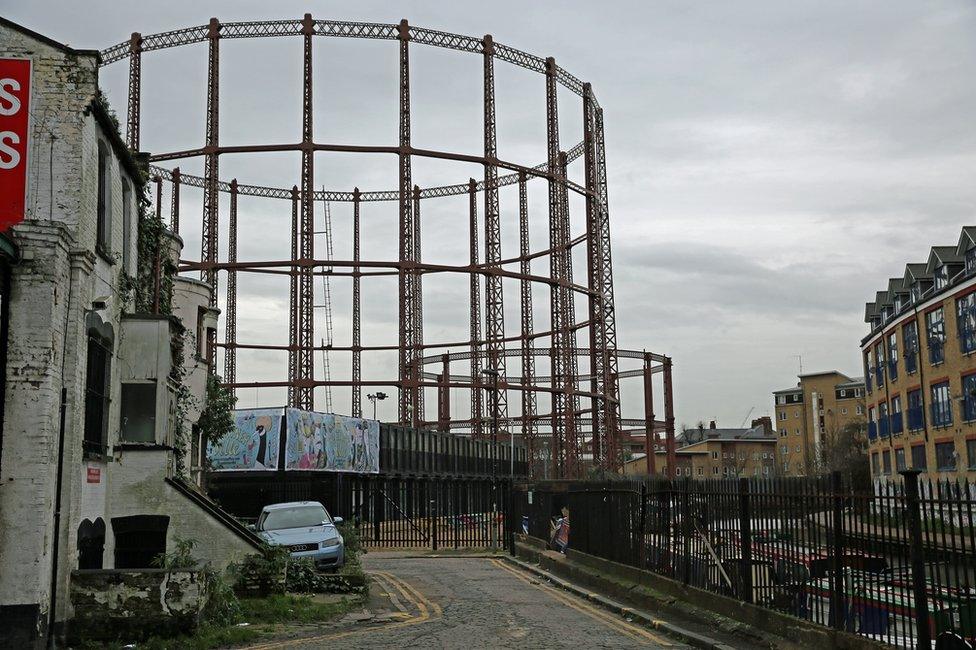
Gas holders in Bethnal Green in east London are also under threat
"I would sit in the back of my parents' car as we drove down the motorway and wonder at the size of them - sometimes filled with a massive column, sometimes mysteriously empty and see-through."
It's not hard not to be curious when the structures are so big - so unique. "I've visited over 30 in London and I'm now starting to make trips to see them around the UK," O'Carroll says. "The shapes are exciting. I want to see them before they go."
As well as the uniqueness of their outline, the gas holders are a testament to Britain's role in creating the Industrial Revolution.
"The UK has been using gas for the past 200 years," says Keith Johnson, a land regeneration manager working for National Grid, as he stands on the somewhat dilapidated site of the Washwood Heath Gas Holders in an industrial park in Birmingham.

"Gas used to be made from burning coal. Coal would be brought to an incinerator near one of the holders via train or boat," he explains. "As the gas was pumped into the holders, the domed container would rise, telescoping up in enormous metal sections, guided by its steel framework."
And so, the cylinders would rise. Slowly led from the ground by wheels tracing upright girders, the gas holder would fill up.
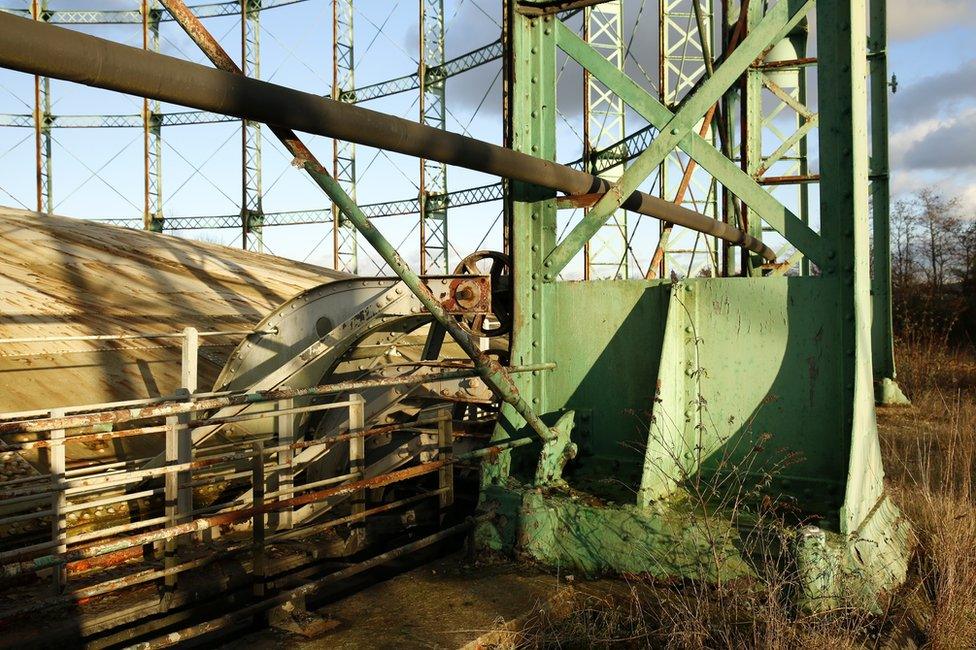
The base of Gas Holder Number Eight at Washwood Heath in Birmingham
In big gas-hungry cities the holders would go up and down daily. Filled in quiet times during the day, in the evening the levels would sink back down as gas was used to light and heat homes.
Christopher Costelloe, director of the Victorian Society, says it's that evocative movement that people like. "It reflects the beating of a human heart on a city scale, they were a reminder of a city's vitality."
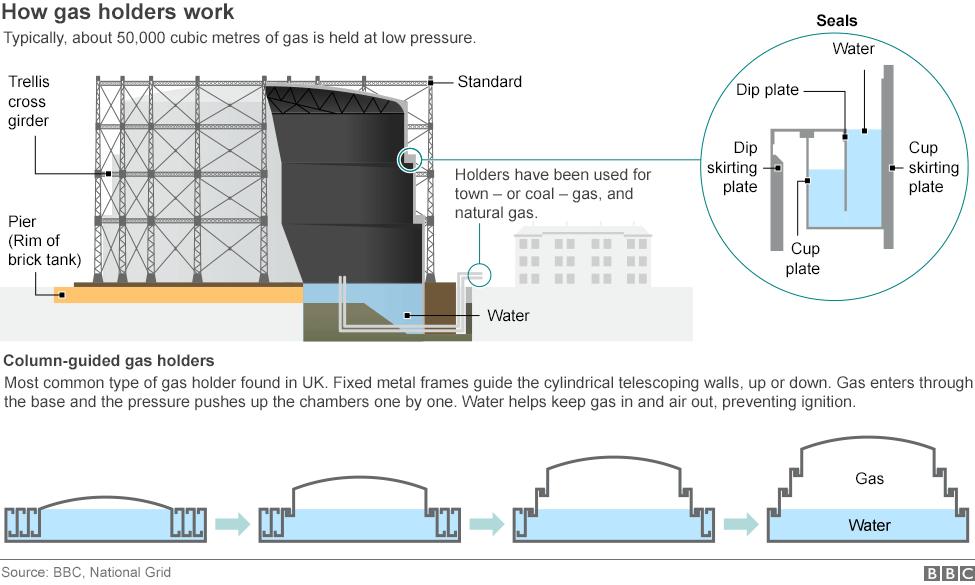
Standing next to one of the 28 enormous metal column feet, Johnson patiently explains why they have to go.
"The National Grid is not a property company," insists Johnson. "We've been going through a programme of demolition for the last 15 years. And it will probably last for another 20. By getting rid of them we are giving the land back to developers. It's a massive opportunity. It's true that they have been part of the community in the past, but that value has now gone."
The disused holders' existence costs vast amounts of money, Johnson says. "We'd have to maintain them structurally and make sure that the sites are secure," says Johnson. "Urban explorers" have been known to break into the sites and try to climb the metal frames.
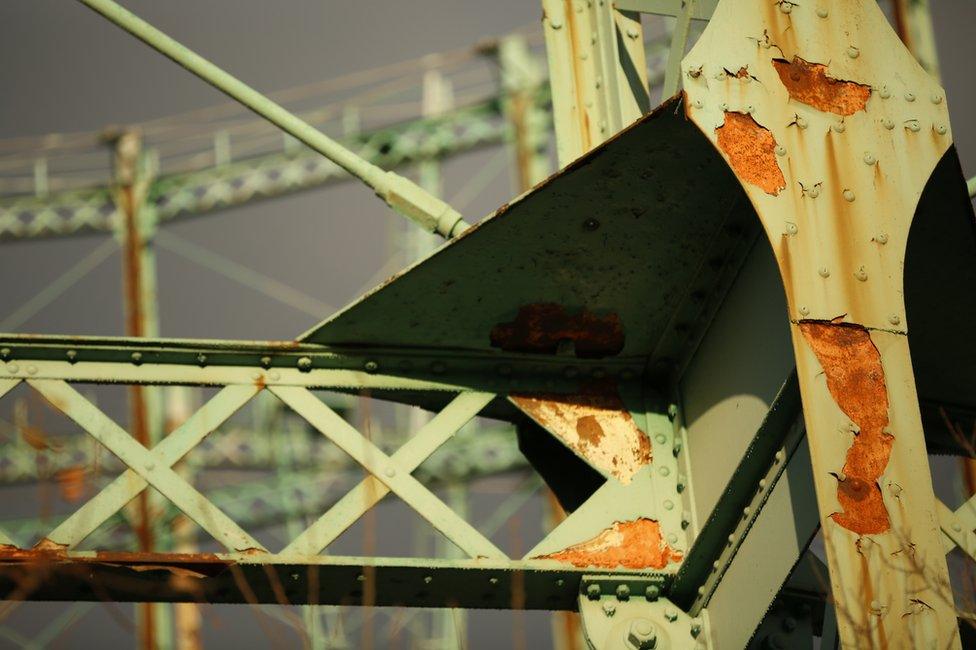
Paint is peeling off some of the gas holders
At Washwood Heath, overgrown weeds and bracken have been left to grow unhampered, sprawling around the now dormant bases. The old domes lie dented and the water, used to seal the gas in, lies stagnant.
When you get up close, it's true that many gas holders are starting to look unloved. Thick layers of old paint curl on the huge columns to reveal the rusty metal beneath. But there is an undeniable beauty and fading grandeur in their decay.

The pylon stays, the gas holder will go
"These ones have a diameter of about 70m and are around 65m high," says Johnson. "Below ground the water tanks go down around 14m."
Anyone driving into London from the east over Christmas 2014 might have seen a gas holder in Edmonton being demolished.
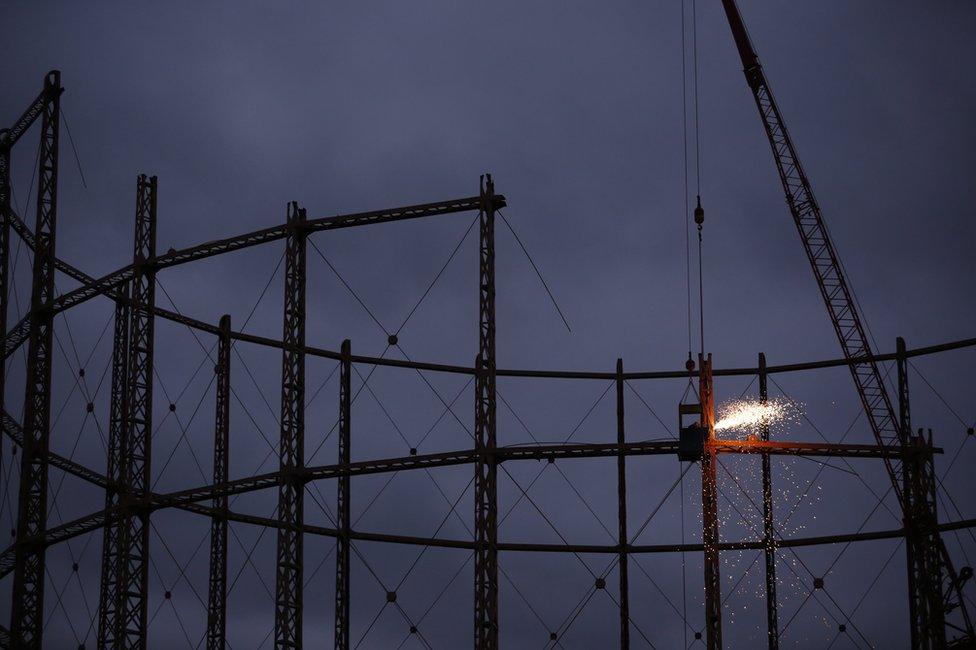
Plasma cutters are used to chop the metal on the frames
"Dismantled is probably a better word for it," says Johnson. The process is done with methodical accuracy.
A team of around 15 men use two cranes. One crane dangles a basket carrying a masked worker, know as a "burner", who uses a plasma cutter to sever huge sections of the metal guiders. The second crane holds the sections as they are worked on, ready to lower them down to the ground once sheared off.
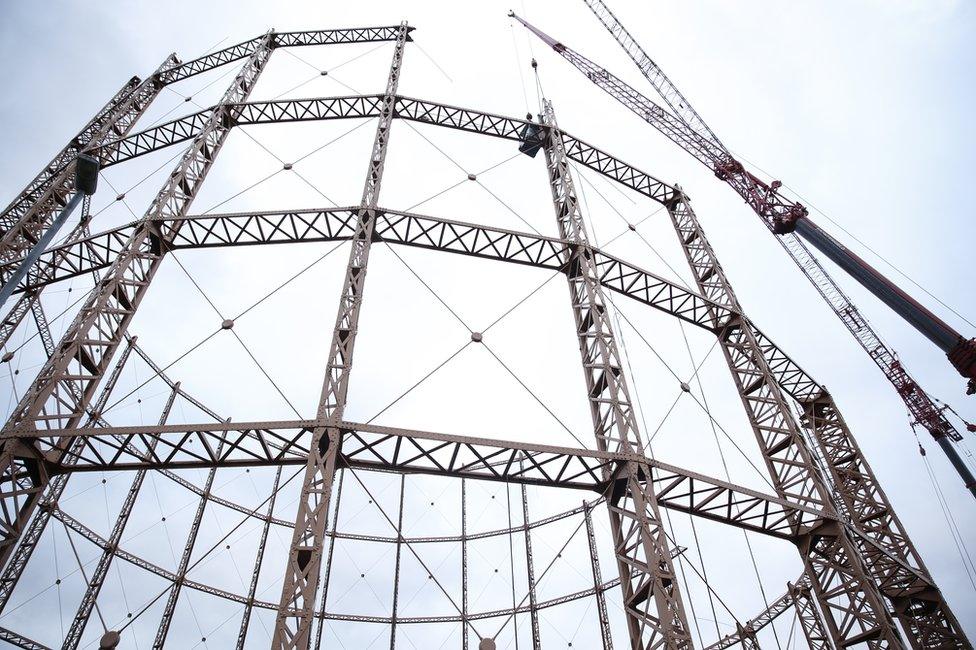
It takes months. Work is due to start on the two in Birmingham in February - they won't be gone until the following Christmas.
Back in Edmonton, Luke Shepherd says he isn't sad to see them go. He is the site manager overseeing the demolition. "I've been taking them down for the last 10 years. It keeps us in work, the holders are not doing anything, just sitting here unused, and if the land can be used for a better purpose then, so be it.
"There is a lot of metal here and we recycle everything that we remove. The older, more ornate gas holders can look impressive, but ones like this, I think many people will be glad to see them go."
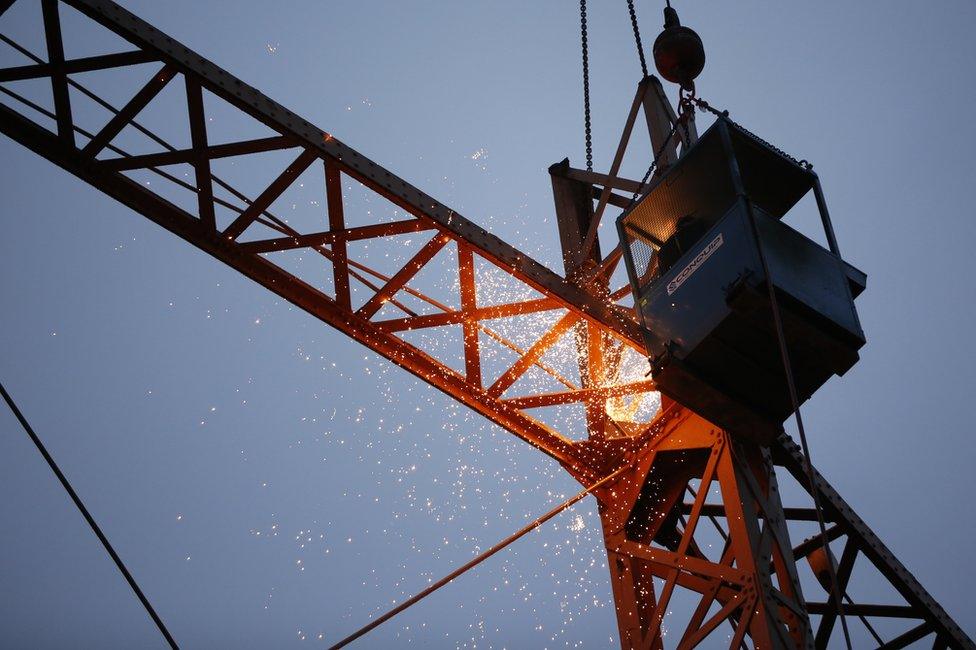
Cutting work at Edmonton
Of course, O'Carroll disagrees. "It's a feeling of loss. Seeing them at different times of day with different lighting changes the impression you have of them. Their majesty and beauty come from a reminder of their functionality."
And Costelloe takes the same view. "Our industrial past is becoming less and less visible, People see things that have been around at the same time as Dickens and Engels and it gives them a sense of connection with the past."
But he goes further: "Its not just their history that makes them special. Primarily they are beautiful structures - if they are new and built today they would retain that quality, and we'd want to keep them. It's the spider's web of iron that makes them unique."

Dusk falls at the gas holder in Edmonton
Saving the gas holders has been on many people's agenda for years. The don't just make a good picture for Instagram, they mark a transition in our cites - the introduction of gas into people's homes, giving warmth and light to the masses.
East End Waterway Group is fighting to ensure the gas holders in Bethnal Green in east London are preserved after learning that the National Grid is looking to have them dismantled. The group points out that the local council has a plan, external that allocates the site for housing and a park. But the plan does say that "the industrial heritage presented by the gas holders within the Regents Canal Conservation area should be acknowledged within the design and layout of the site". A spokeswoman for Tower Hamlets council says: "The area… was given conservation area status to protect it by the council in 2008. However, the structures are owned by the National Grid, and disposal of them is decided through consultation with English Heritage and a final decision by the secretary of state."
The older, smaller and more ornate of the pair at Bethnal Green, Gas Holder Number Two, was completed in 1866. The other simpler and larger structure was finished in 1889.
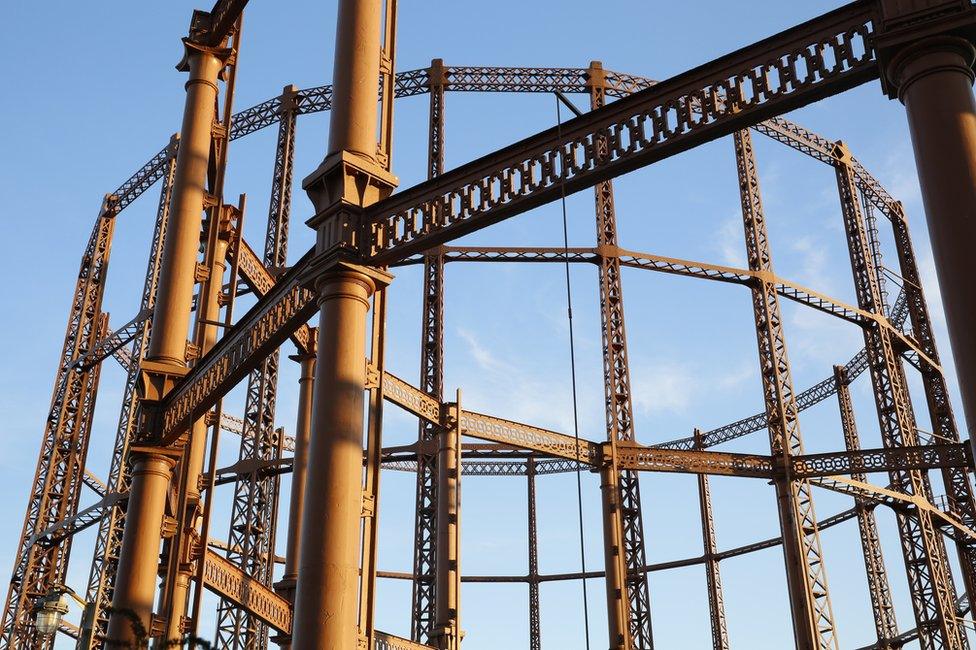
The Bethnal Green gas holders, with their intricate metalwork, are being considered for listing
Standing at 44.5m tall, Number Five is twice the height of Number Two.
English Heritage say they currently have listed 12 gas holder sites for preservation. They are looking at the Bethnal Green holders for listing and will soon be putting their advice report forward to the Department for Culture, Media and Sport.
Although there has been support for a programme that would retain the structures, not all locals would regret the removal. "I'm surprised that they haven't been taken down already," says Sarah Neary, a civil servant, who has lived in a flat right next to the gas holders for six months. "They are in the way here. I do think I might miss them if they went, but we are in central London and we need all the space we can get for housing."

Land is valuable in east London where these gas holders sit
A project in Kings Cross in London is doing just that. Gas Holder Number Eight has been taken down, moved slightly and will be reinstated and used as part recreation ground and event space. Gas Holders 10, 11 and 12 will be reinstated and developed into flats.
"Very few places can afford such a vast investment of money, the cost of such projects is enormous," argues Johnson. And Costelloe remains wary of such projects: "It's easy to lose the intangible importance of gas holders - the hollow space that they occupy, not perhaps the building itself, is not always picked up by listing."
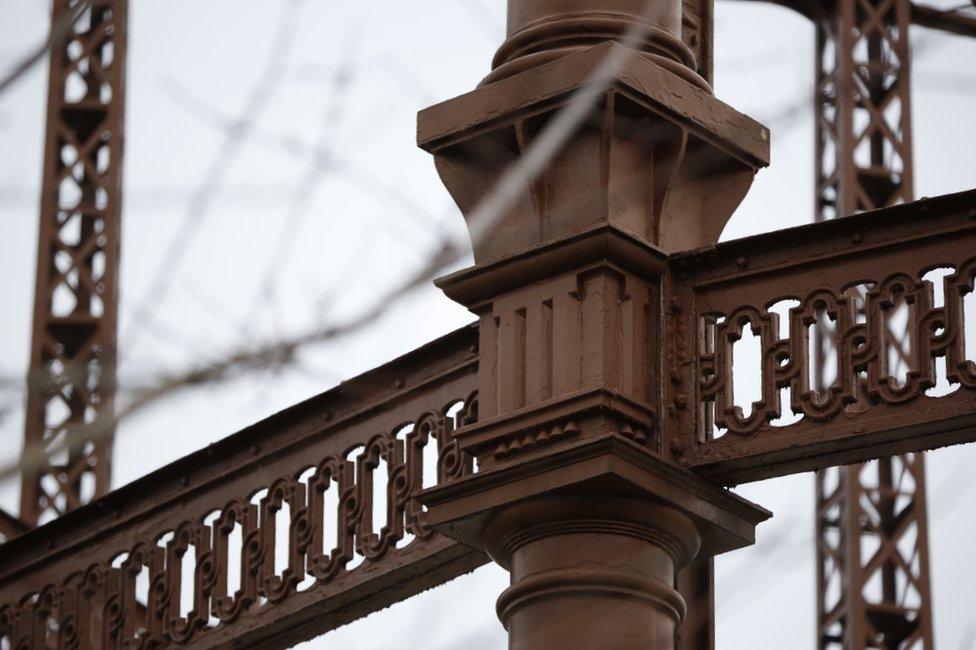
The younger gas holders, deemed less pretty, are less likely to survive. In the same way that their very existence was born of necessity - it seems, so too is their demise.
National Grid say that they are working hard with English Heritage to archive and commemorate the holders that are being removed. But it is that enough? It's not the memory of them that is impressive - it's the size and the void of space that they assume.
Like it or not, the truth is that the metal giants of the past are being slowly but surely being picked away from our skylines. For O'Carroll, and many other who have gazed at them out of a train window or from the back seat of a car, the real loss may not be the holders themselves, but perhaps the awe and childlike wonder that only very few things can inspire.

Pictures by Ed Ram

Gas holders or gasometers?
Gas holders are also known as gasometers, a term coined by the inventor of gas lighting, William Murdoch. To the disgruntlement of his contemporaries, who complained that this so-called gasometer was not a meter but a container, the name gasometers stuck and slid into general use. To avoid confusion, the structures are now most commonly referred to as gas holders, though gasometer is still accepted.
